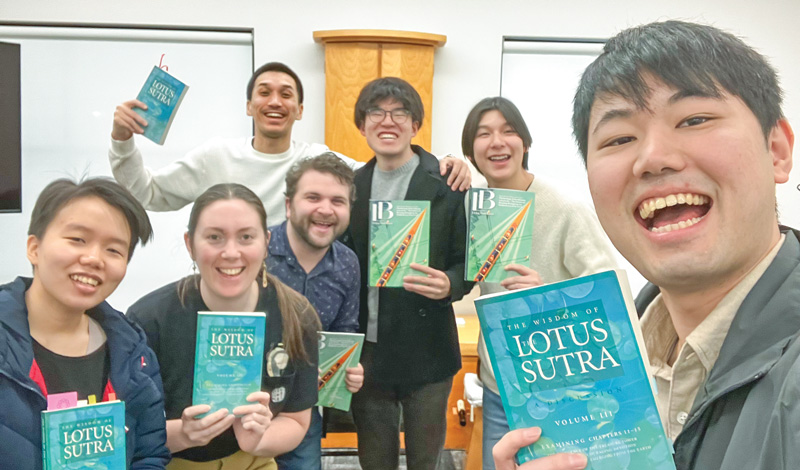Ikeda Wisdom Academy members:
• are district through national youth leaders and all student division members.
• should have their own copy of The Wisdom of the Lotus Sutra, vol. 4.
• are encouraged to read the assigned material before each meeting.
March Syllabus:
The Wisdom of the Lotus Sutra, vol. 4, pp. 3–28
• Part One: “The Life Span of the Thus Come One” Chapter: To Learn About Death Is to Learn How to Live
1: “An Irrepressible Zest for Life—the Spirit of the ‘Life Span’ Chapter”
Supplementary Material:
• The Lotus Sutra and Its Opening and Closing Sutras, pp. 265–73
• The Record of the Orally Trans-mitted Teachings, pp. 123–43
Chapter Overview
The ‘Life Span’ Chapter Reveals That We Are All Buddhas
The seventh class of Ikeda Wisdom Academy begins this month! In this class, which will run from March 2025 to January 2027, we will study The Wisdom of the Lotus Sutra, volumes 4 and 5, which cover chapters 16 through 22 of the Lotus Sutra.
The entirety of volume 4 is dedicated to the sutra’s 16th chapter, “The Life Span of the Thus Come One.” This chapter describes the pivotal moment when Shakyamuni Buddha reveals to his disciples that he did not first attain enlightenment under the bodhi tree, as they had understood. He says:
Since I attained Buddhahood, an extremely long period of time has passed. My life span is an immeasurable number of asamkhya kalpas, and during that time I have constantly abided here without ever entering extinction. (The Lotus Sutra and Its Opening and Closing Sutras, pp. 267–68)
This revelation overturns his disciples’ view of the Buddha and upends all his earlier pre-Lotus Sutra teachings. In essence, he casts off his transient identity as a provisional Buddha who first attained enlightenment in his present existence in India and reveals his true identity as the Buddha enlightened since the remote past.
It is here that Shakyamuni expresses the eternal nature of life and death and our ever abiding and inherent Buddhahood. Regarding the profound meaning of this chapter, Ikeda Sensei said:
The purpose of the “Life Span” chapter is to explain that all living beings, not just Shakyamuni, have in fact been Buddhas since the remote past and to cause people to become aware of this. Its purpose is to open people’s eyes to the great and eternal life of the universe. Nichiren Daishonin’s revelation of the implicit teaching of the Lotus Sutra [Nam-myoho-renge-kyo] makes it possible on a practical level for people to do so. (WLS-4, 16)
—Prepared by the SGI-USA Study Department
Ikeda Sensei’s Guidance
The Empowering View of the Eternity of Life
Everyone fears and is saddened by death. That is natural. But by struggling to overcome the pain and sadness that accompanies death, we become aware of the dignity of life and develop the spirit to share the sufferings of others as our own. …
Life is long, and it is not all clear skies. There are rainy days and days of fierce wind. But no matter what happens, as long as we maintain our faith, in the end everything that happens will turn into benefit. …
We have to live out our lives with firm belief in the eternity of life. Through our victory in this life, we show proof of life’s eternity. This is the teaching of the Lotus Sutra and of the “Life Span” chapter. (WLS-4, 9–10)
Digging Deep
March Study Guide
Please use these questions to guide your study of the March Ikeda Wisdom Academy material in The Wisdom of the Lotus Sutra, vol. 4, pp. 3–28.
1) Sensei says: “In life, nothing is more certain than the fact that one will someday die. Everything else is indefinite and subject to change” (The Wisdom of the Lotus Sutra, vol. 4, p. 3).
What does he say about those who lack a sound understanding and perspective on life and death? (WLS-4, 4)
2) Sensei says: “The ‘Life Span’ chapter reveals the boundlessness of life, which is eternal and as vast as the universe. And the practice of the ‘Life Span’ chapter is to manifest that immense life in the reality of our own lives” (WLS-4, 10).
What is the “eternal life” described in the “Life Span” chapter? (WLS-4, 10–11)
3) In “Emerging from the Earth,” the Lotus Sutra’s 15th chapter, Shakyamuni calls forth countless Bodhisattvas of the Earth, whom he had been teaching since the beginningless past. He reveals that they would be the ones to propagate the Law into the future. Seeing this, doubts begin to fill the minds of his followers who thought Shakyamuni had attained enlightenment in his present life in India.
What was Shakyamuni’s response? What Buddhist principle does this illustrate? (WLS-4, 12–14)
4) Shakyamuni then makes a declaration that overturns the prevailing common wisdom about life, death and attaining Buddhahood. Namely, that since attaining Buddhahood he has been constantly in this (the saha) world expounding the Law and instructing the people.
What does this mean for us and our practice? (WLS-4, 15–18)
5) The sutra states, “There is no ebb or flow of birth and death, and there is no existing in this world and later entering extinction” (The Lotus Sutra and Its Opening and Closing Sutras, p. 267).
What does Nichiren say to take our understanding of this passage one step further? How do we experience life and death in a way that, as Sensei says, “our existence becomes a source of inexhaustible joy”? (WLS-4, 18–19)
Looking Forward: April Syllabus
The Wisdom of the Lotus Sutra, vol. 4, pp. 29–54
Part One: “The Life Span of the Thus Come One” Chapter: To Learn About Death Is to Learn How to Live
2: “The Supreme Dignity of the Human Being”
You are reading {{ meterCount }} of {{ meterMax }} free premium articles

